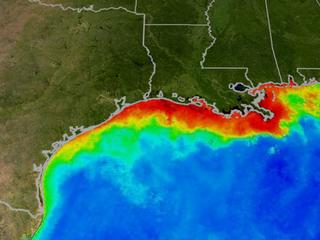Learn which biofuels require less inputs and strategies to reduce pollution.
 |
| Nitrates are most frequently detected in groundwater where nitrogen fertilizer is most heavily used; but exceptions to this pattern occur. USGS image. |
Table Of Contents
Water Quality
Biofuel crops can help improve water quality because some need less fertilizer, are perennials, and have a more closed canopy. In order for production of agricultural energy crops to be considered sustainable, practices must be in place to protect water quality. Specifically, non-point source contaminants must be managed to avoid pollution. The dominant non-point source contaminants of surface waters include nitrogen, phosphorus, and sediment. Protecting ground and surface waters depends on reducing nutrient loading, increasing nutrient uptake by plants, and limiting water runoff and erosion (Sharpley et al. 2003). These approaches make sense for biomass energy crops as well as commodity food crops.
Nitrogen, phosphorus, and sediment are discussed further below. You will also learn how to anticipate impacts on water quality and quantity from bioenergy crop production and processing through the curriculum unit on Water Resources: Issues & Opportunities in Bioenergy Generation.
Nitrogen
Nitrogen requirements vary between potential feedstocks, and nitrate leaching increases with increasing nitrogen application rates (Jaynes et al. 2001). Generally, nitrogen recommendations for corn are about twice as high as for switchgrass (Rinehart 2006; Teel et al. 2003; Elbersen et al. 2004; Vogel et al. 2002; Vitosh et al. 1995; Blackmer et al. 1997). Hybrid poplar nitrogen recommendations, based on tissue tests, are typically lower than for either corn or switchgrass (Hansen et al. 1993). Diverse plant mixtures may require very little nitrogen (Tillman et al. 2006).

Phosphorus and sediment
Phosphorus application rates are based on soil test results. In general, crops respond to increasing soil phosphorus concentrations up to a given level, after which further additions of phosphorus have little yield effect but can affect the quality of water leaving the field. As phosphorus moves primarily with soil sediment, control of soil erosion and sediment nutrient delivery to surface water is critical (Sharpley et al. 2003). Biomass production that depends on removing annual row crop residue, will likely result in more sediment movement — and greater phosphorus delivery to surface water — than biomass production from perennial crops like switchgrass or poplar.
References
- Blackmer, A.M., R.D. Voss, and A.P. Mallarino. 1997. Nitrogen fertilizer recommendations for corn in Iowa. Pm-1714. Iowa State Univ., Ames, IA.
- H. W. Elbersen, D.G. Christian, N. El Bassam, G. Sauerbeck, E. Alexopoulou, N. Sharma, and I. Piscioneri. 2004. A management guide for planting and production of switchgrass as a biomass crop in Europe. 2nd World Conference on Biomass for Energy, Industry and Climate Protection, 10-14 May 2004, Rome, Italy. Pp. 140 – 142.
- Hansen, Edward A., Daniel A. Netzer, and David N. Tolsted. 1993. Guidelines For Establishing Poplar in the North Central U.S. USDA Forest Service Research note NC-363.
- Jaynes, D.B., T.S. Colvin, D.L. Karlen, C.A. Cambardella, and D.W. Meek. 2001. Nitrate loss in subsurface drainage as affected by nitrogen fertilizer rate. J. Environ. Qual. 30:1305–1314.
- Rinehart, Lee. 2006. Switchgrass as a bioenergy crop. National Sustainable Agriculture Information Service. ATTRA Publication #IP302
- Sharpley, A. N., Weld, J. L., Beegle, D. B., Kleinman, P. J. A., Gburek, W. J., Moore, P. A., & Mullins, G. (2003) Development of phosphorus indices for nutrient management planning strategies in the United States. Journal of Soil and Water Conservation 58(3):137-151.
- Teel, A., S. Barnhart, and G. Miller. 2003. Management Guide for the Production of Switchgrass for Biomass Fuel in Southern Iowa (PDF / 802 K). Iowa State University Extension.
- Tilman, David, Jason Hill, Clarence Lehman. 2006. Carbon-Negative biofuels from low-input high-diversity grassland biomass. Science. 314:1598-1600.
- Vitosh,M.L., J.W. Johnson, andD.B.Mengel. 1995. Tri-state fertilizer recommendations for corn, soybeans, wheat, and alfalfa. Michigan State University Ext. Bull. E-2567.
- Vogel, K.P., J.J. Brejda, D.T. Walters, and D.R. Buxton. 2002. Switchgrass biomass production in the Midwest USA: Harvest and nitrogen management. Agron. J. 94:413–420.
Contributors
Authors
- Rick Cruse, Professor of Agronomy and Director of the Iowa Water Center, Iowa State University
- Michael Bomford, Kentucky State University
Peer Reviewers
- Vern Grubinger, Professor, University of Vermont Extension
- Mike Morris, National Center For Appropriate Technology (ATTRA)
